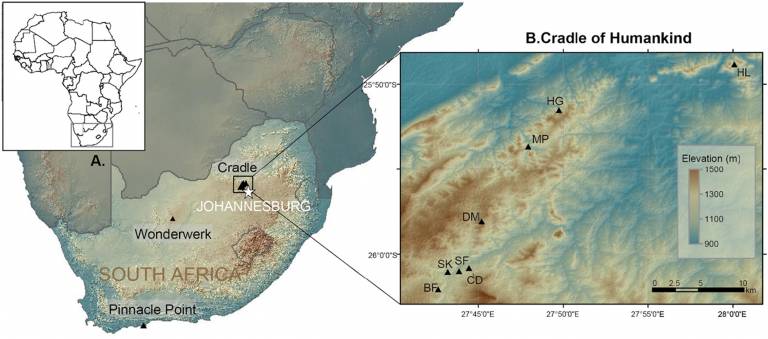Uranium-Lead Dating of South African Plio-Pleistocene Cave Systems
2 June 2021
We look for patterns within these data and find that in general, the U concentration has little to no effect on age quality, while the lower Pb concentration, the better. Our data confirms the expected negative exponential relationship between U-Pb age and 234U/238U.

Caves in South Africa preserve a rich record of early hominin and early modern human development and have been the subject of much research. U-Pb dating of speleothems, particularly flowstones, has provided a much-needed chronology for cave sites in the Cradle of Humankind, the coastal cliff caves at Pinnacle Point and at the archaeological site of Wonderwerk Cave. The U-Pb ages range from ~3 Ma to just under 1 Ma and altogether represent a relatively large dataset of 35 U-Pb ages, from 34 flowstone samples, consisting of a total of 291 individual matched U and Pb isotope analyses. We look for patterns within these data and find that in general, the U concentration has little to no effect on age quality, while the lower Pb concentration, the better. Our data confirms the expected negative exponential relationship between U-Pb age and 234U/238U. There is no apparent relationship between U concentration and residual 234U/238U, suggesting U concentration patterns are controlled by 238U, not 234U. We divide the 35 U-Pb ages into three categories defined by the % error on the U-Pb age (the good, the bad and the ugly). We use the U and Pb isotope data, thin section petrography and laser ablation trace element transects through the flowstones to investigate the factors controlling the quality of the ages. The ‘good’ ages are produced by the coincidence of several features: a large number of points (10 or more) defining their isochrons, radiogenic 206Pb/204Pb ratios, with a few very radiogenic points defining the line of the isochron, U concentrations of ~1 ppm and well-preserved trace element signals. ‘Bad’ ages are caused by deficit in one of these factors but may be redeemed with additional analysis to better define the line of isochron and constrain initial 234U/238U. The ‘ugly’ ages are attributable to low levels of radiogenic Pb, a low spread of isochron and high Pb concentrations, possibly from detrital material. We show what a completely recrystallized flowstone looks like, where the original trace element signals are completely obliterated, and it is impossible to resolve a U-Pb age. The thin section petrography reveals all flowstones have undergone heavy diagenesis, with the dominant fabric observed consisting of mosaic calcite with relic aragonite. However, we argue that the preservation of trace element signals, in particular the abrupt, sympathetic step-like variation is Sr, U and in some cases Ba and Mg, indicate that this diagenesis is conservative. We identify a mixture of crystal and fluid dominated trace element patterns, both of which are ultimately related to flow dynamics, in turn related to changes in external hydroclimate. This hints at the potential to extract valuable palaeoclimate records out of these old, U-Pb dated flowstones, which would be very interesting given their association with important early human evolution sites in South Africa.
Factors controlling age quality in UPb dated Plio-Pleistocene speleothems from South Africa: The good, the bad and the ugly.
Robyn Pickering and Tara R. Edwards
DOI: 10.1016/j.chemgeo.2021.120364
 Close
Close

